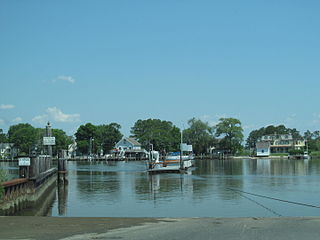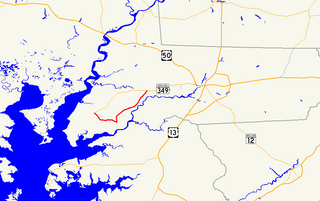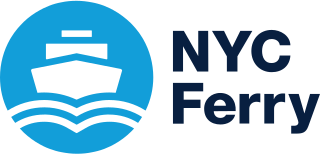Related Research Articles

The Delmarva Peninsula, or simply Delmarva, is a large peninsula on the East Coast of the United States, occupied by the vast majority of the state of Delaware and parts of the Eastern Shore regions of Maryland and Virginia. The peninsula is 170 miles (274 km) long. In width, it ranges from 70 miles (113 km) near its center, to 12 miles (19 km) at the isthmus on its northern edge, to less near its southern tip of Cape Charles. It is bordered by the Chesapeake Bay on the west, Pocomoke Sound on the southwest, the Delaware River, Delaware Bay, and the Atlantic Ocean on the east.

Wicomico County is located in the southeastern part of the U.S. state of Maryland, on the Delmarva Peninsula. As of the 2010 census, the population was 98,733. The county seat is Salisbury. The county was named for the Wicomico River, which in turn derives from Algonquian language words wicko mekee, meaning "a place where houses are built," apparently referring to a Native American town on the banks.

The Woolwich Ferry is a free vehicle and pedestrian ferry across the River Thames in East London, connecting Woolwich on the south bank with North Woolwich on the north. It is licensed and financed by London River Services, the maritime arm of Transport for London (TfL). Around two million passengers use the ferry each year.

The Maryland Transit Administration (MTA) is a state-operated mass transit administration in Maryland, and is part of the Maryland Department of Transportation. The MTA operates a comprehensive transit system throughout the Baltimore-Washington Metropolitan Area. There are 80 bus lines serving Baltimore's public transportation needs, along with other services that include the Light Rail, Metro Subway, and MARC Train. In 2021, the system had a ridership of 44,612,100, or about 145,000 per weekday as of the fourth quarter of 2021. With nearly half the population of Baltimore residents lacking access to a car, the MTA is an important part of the regional transit picture. The system has many connections to other transit agencies of Central Maryland, Washington, D.C., Northern Virginia, and south-central Pennsylvania : WMATA, Charm City Circulator, Regional Transportation Agency of Central Maryland, Annapolis Transit, Rabbit Transit, Ride-On, and TransIT.

A cable ferry is a ferry that is guided across a river or large body of water by cables connected to both shores. Early cable ferries often used either rope or steel chains, with the latter resulting in the alternative name of chain ferry. Both of these were largely replaced by wire cable by the late 19th century.

The Wicomico River is a 24.4-mile-long (39.3 km) tributary of the Chesapeake Bay on the eastern shore of Maryland. It drains an area of low marshlands and farming country in the middle Delmarva Peninsula.

The Eastern Shore of Maryland is a part of the U.S. state of Maryland that lies mostly on the east side of the Chesapeake Bay. Nine counties are normally included in the region. The Eastern Shore is part of the larger Delmarva Peninsula that Maryland shares with Delaware and Virginia.

Hampton Roads Transit (HRT), incorporated on October 1, 1999, began through the voluntary merger of PENTRAN on the Virginia Peninsula and TRT in South Hampton Roads and currently serves over 22 million annual passengers within its 369-square-mile (960 km2) service area around Hampton Roads. The purpose of the HRT is to provide reliable and efficient transportation service and facilities to the Hampton Roads community. In 2021, the system had a ridership of 6,437,600, or about 20,300 per weekday as of the fourth quarter of 2021.

The IRT Third Avenue Line, commonly known as the Third Avenue Elevated, Third Avenue El, or Bronx El, was an elevated railway in Manhattan and the Bronx, New York City. Originally operated by the New York Elevated Railway, an independent railway company, it was acquired by the Interborough Rapid Transit Company (IRT) and eventually became part of the New York City Subway system.

Kent Island is the largest island in the Chesapeake Bay and a historic place in Maryland. To the east, a narrow channel known as the Kent Narrows barely separates the island from the Delmarva Peninsula, and on the other side, the island is separated from Sandy Point, an area near Annapolis, by roughly four miles (6.4 km) of water. At only four miles wide, the main waterway of the bay is at its narrowest at this point and is spanned here by the Chesapeake Bay Bridge. The Chester River runs to the north of the island and empties into the Chesapeake Bay at Kent Island's Love Point. To the south of the island lies Eastern Bay. The United States Census Bureau reports that the island has 31.62 square miles (81.90 km2) of land area.

The transportation system of New York City is a network of complex infrastructural systems. New York City, being the most populous city in the United States, has a transportation system which includes one of the largest subway systems in the world; the world's first mechanically ventilated vehicular tunnel; and an aerial tramway. New York City is also home to an extensive bus system in each of the five boroughs; citywide and Staten Island ferry systems; and numerous yellow taxis and boro taxis throughout the city. Private cars are less used compared to other cities in the rest of the United States.

Maryland Route 349 is a state highway in the U.S. state of Maryland. Known as Nanticoke Road, the state highway runs 22.32 miles (35.92 km) from a dead end in Nanticoke east to U.S. Route 50 Business in Salisbury. The first segment of MD 349 was constructed by 1910 west of Salisbury. The modern highway reached Quantico by 1919, Bivalve by 1925, and its western terminus by 1933. The only major change to MD 349 since is a realignment near Salisbury in the mid-1950s.

Maryland Route 352 is an east–west state highway in the U.S. state of Maryland. The state highway runs 10.03 miles (16.14 km) between intersections with MD 349 near Bivalve on the west and near Quantico on the east. The Whitehaven Road portion of MD 352 was constructed as a state highway from Catchpenny west to Green Hill Creek in the early 1930s. The state highway was extended south to Whitehaven, the north landing of the Whitehaven Ferry, by 1946. The Capitola Road portion of MD 352 was originally designated MD 385 in the late 1940s and absorbed into MD 352 in the 1960s.

Maryland Route 362 is a state highway in the U.S. state of Maryland. Known as Mount Vernon Road, the state highway runs 6.23 miles (10.03 km) from Bobtown Road near Mount Vernon east to MD 675 in Princess Anne. MD 362 connects Princess Anne with northwestern Somerset County as well as southwestern Wicomico County via the Whitehaven Ferry. The state highway was constructed from U.S. Route 13 beginning in 1929. MD 363 was completed to Mount Vernon in the late 1930s.

Whitehaven Historic District is a national historic district in Whitehaven, Wicomico County, Maryland. It is located at the end of Whitehaven Road on the north bank of the Wicomico River. The Whitehaven Ferry that crosses the river here has been in continuous operation since 1688 or earlier. The district encompasses a late-19th century village, consisting of the Whitehaven Hotel, church, school, marine railway, and 24 houses dating from the 19th century, two 20th century and one 18th century dwellings. It is one of the oldest towns in this part of Maryland, authorized by the General Assembly in the late 17th century.

Whitehaven is an unincorporated community and census-designated place in Wicomico County, Maryland, United States. Its population was 43 as of the 2010 census. It is part of the Salisbury, Maryland-Delaware Metropolitan Statistical Area.

The Whitehaven Ferry is a passenger and automobile cable ferry that crosses the Wicomico River in Whitehaven, Maryland, located to the southwest of Salisbury. The ferry is operated by the Wicomico County Department of Public Works and runs between the community of Whitehaven in Wicomico County to the north and Somerset County in the south. The ferry can carry a maximum of 6 passengers and 3 cars and has a weight limit of 10,000 pounds. The Whitehaven Ferry operates from early morning until the evening every day of the year except Christmas and is free. A ferry has crossed the Wicomico River in the area since 1687. The current ferry is believed to be the oldest continuously operating ferry in the United States. In 2012, the ferry was overhauled and refurbished.

NYC Ferry is a public network of ferry routes in New York City operated by Hornblower Cruises. As of August 2021, there are six routes, as well as one seasonal route, connecting 25 ferry piers in the Bronx, Brooklyn, Manhattan, Queens, and Staten Island. NYC Ferry has the largest passenger fleet in the United States with a total of 38 vessels, providing between 20–90 minute service on each of the routes, depending on the season. One additional route and one new pier are planned as of December 2021.

The Baltimore, Chesapeake and Atlantic railroad, nicknamed Black Cinders & Ashes, ran from Claiborne, Maryland, to Ocean City, Maryland. It operated 87 miles (140.0 km) of center-line track and 15.6 miles (25.11 km) of sidings. Chartered in 1886, the railroad started construction in 1889 and cost $2.356 million ($2022=71,055,000).
References
- 1 2 3 4 "Ferry Schedule". Wicomico County, Maryland. Retrieved May 19, 2015.
- ↑ Wicomico County Bridges, Dams and Ferries (Map). Wicomico County, Maryland. Retrieved May 19, 2015.
- ↑ "Whitehaven and Upper Ferry". www.wicomicorecandparks.org. Retrieved 2017-06-19.
- ↑ "Whitehaven & Upper Ferry". Wicomico County Convention and Tourist's Bureau. Retrieved May 19, 2015.
- ↑ Junkin, Vanessa (August 4, 2014). "Whitehaven Ferry : A trip across river –– back in time". DelmarvaNow. Retrieved May 19, 2015.